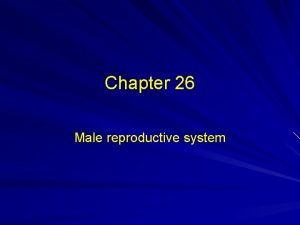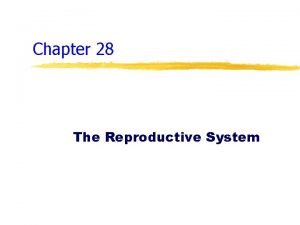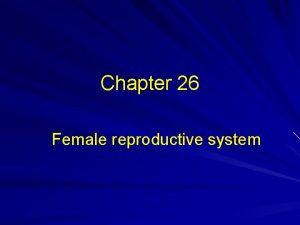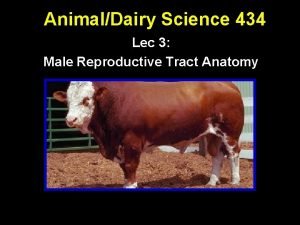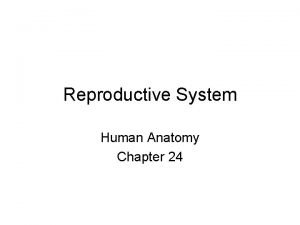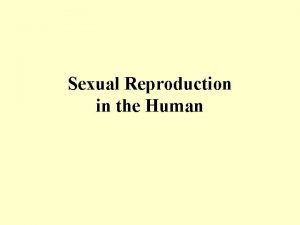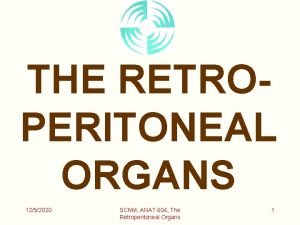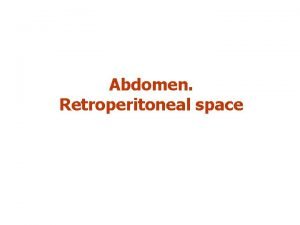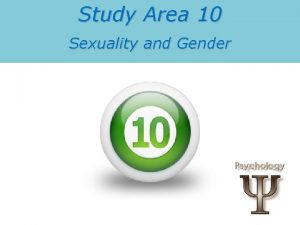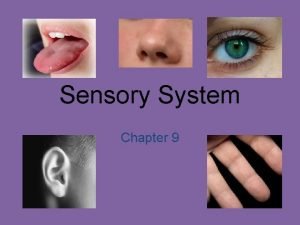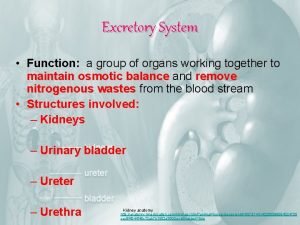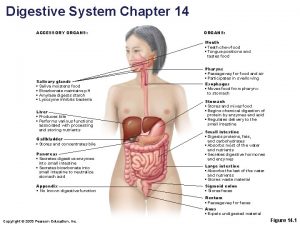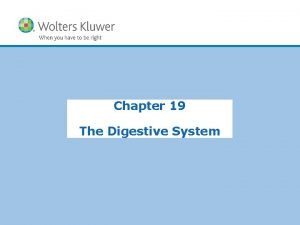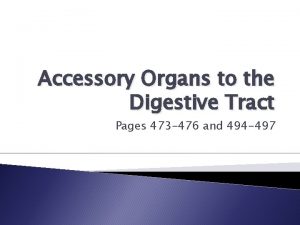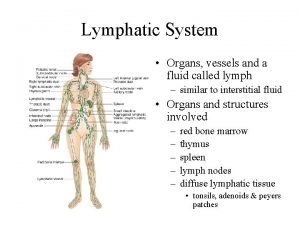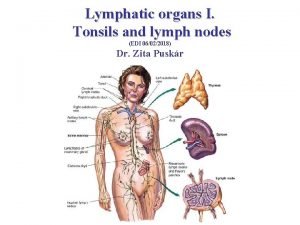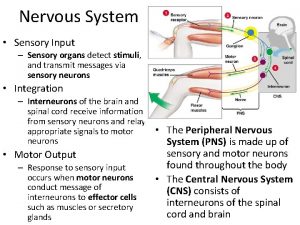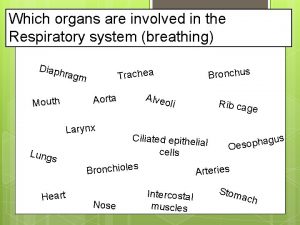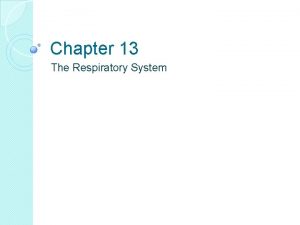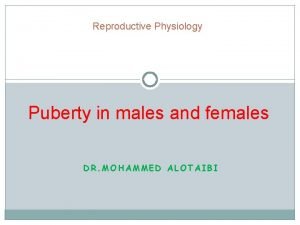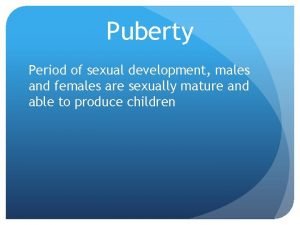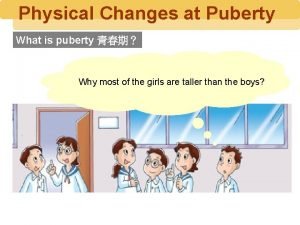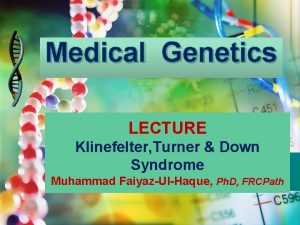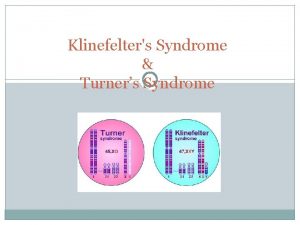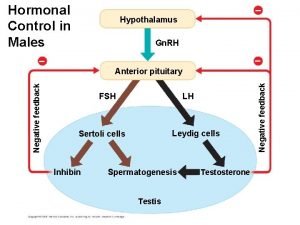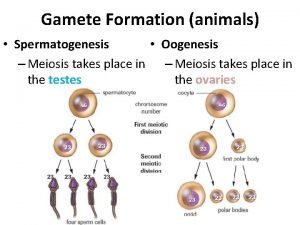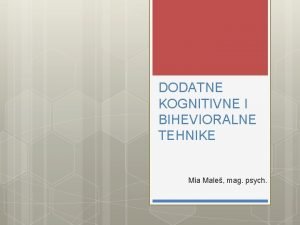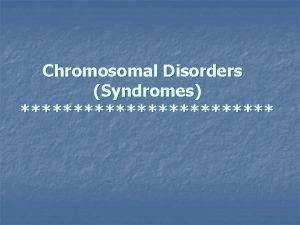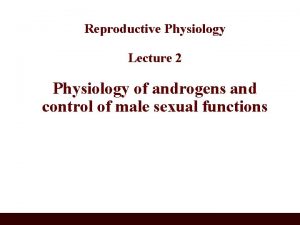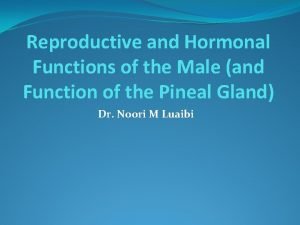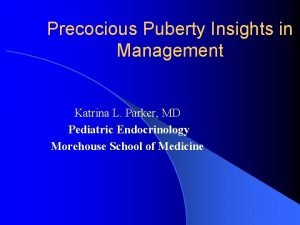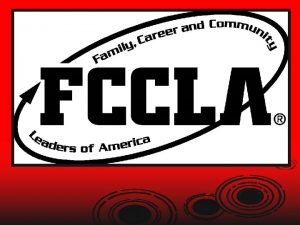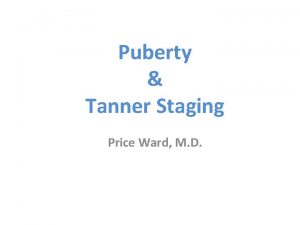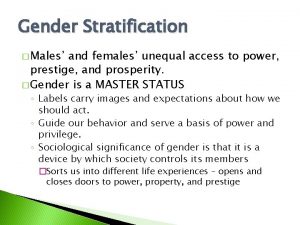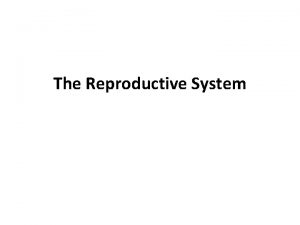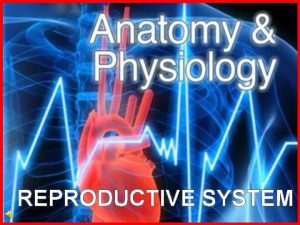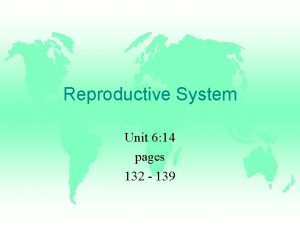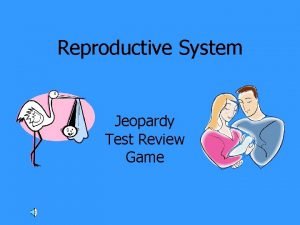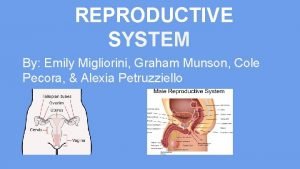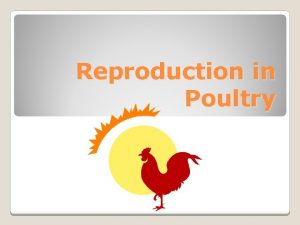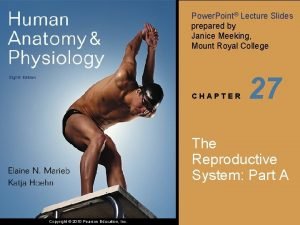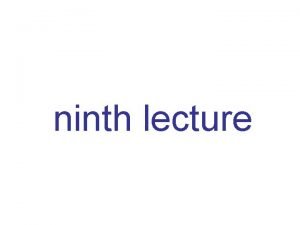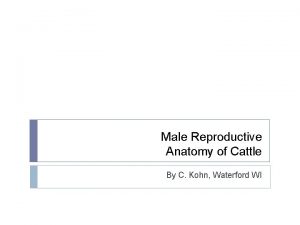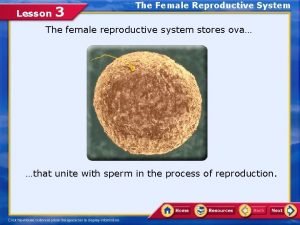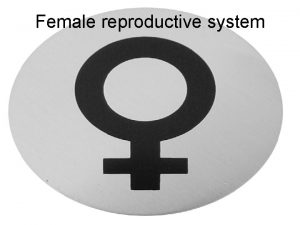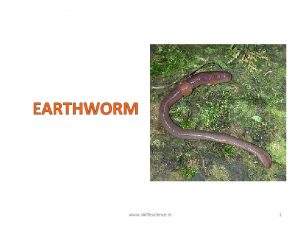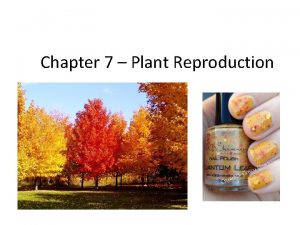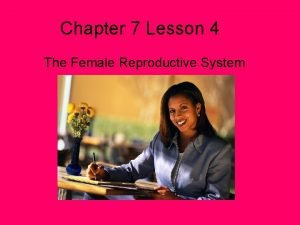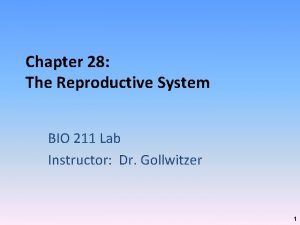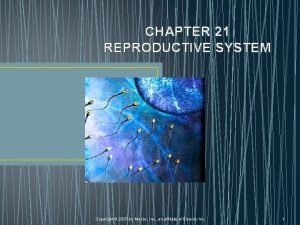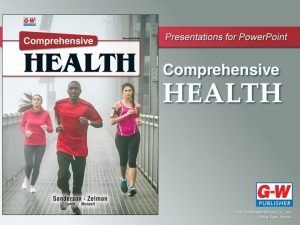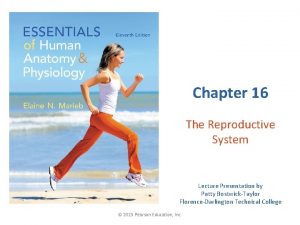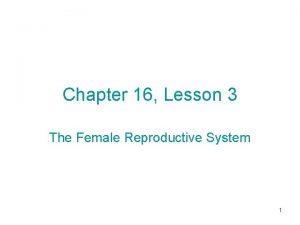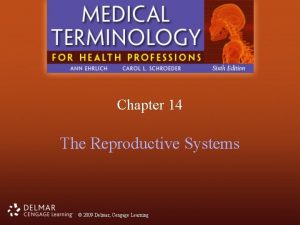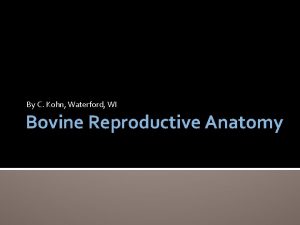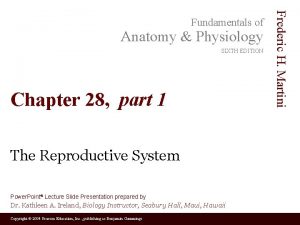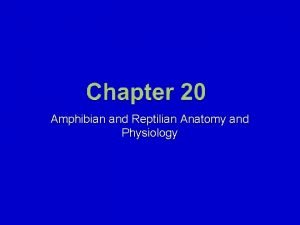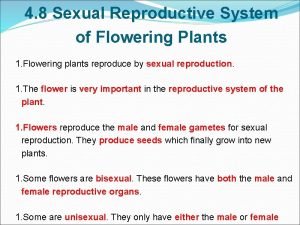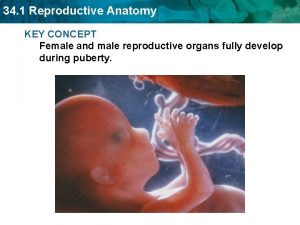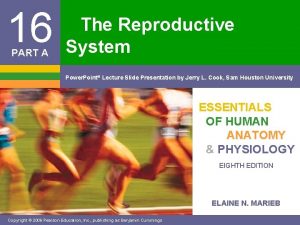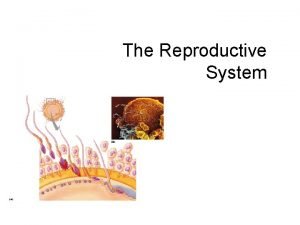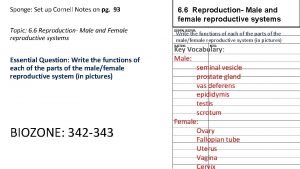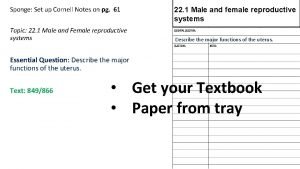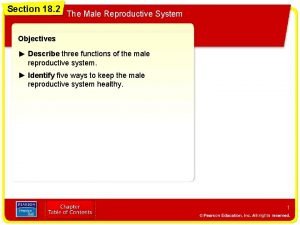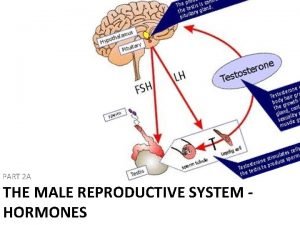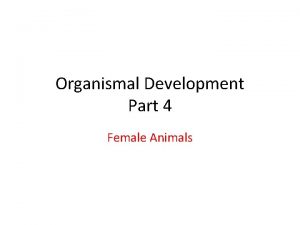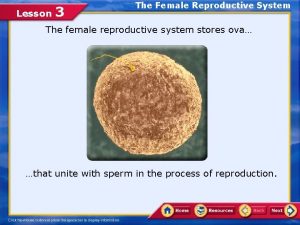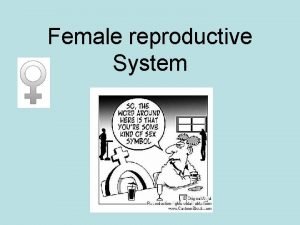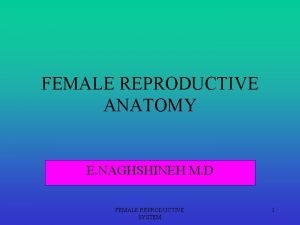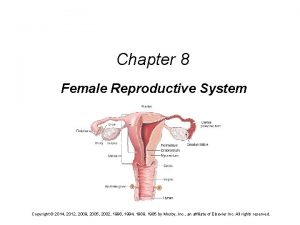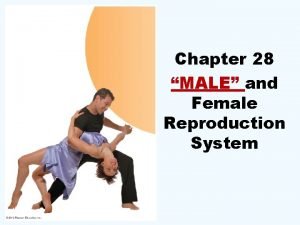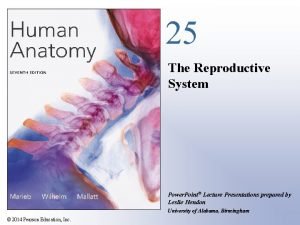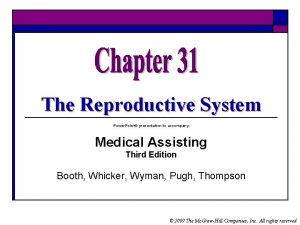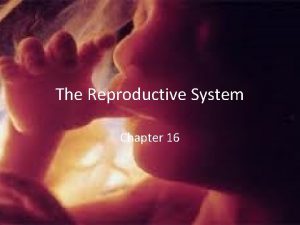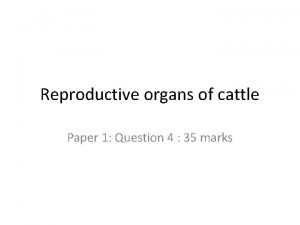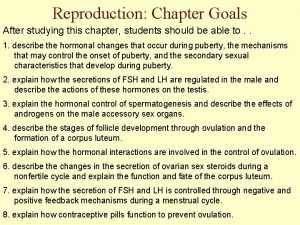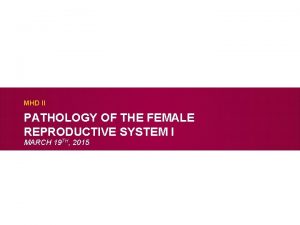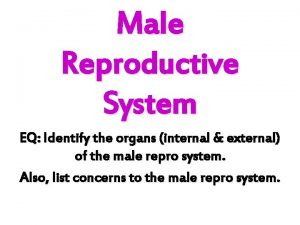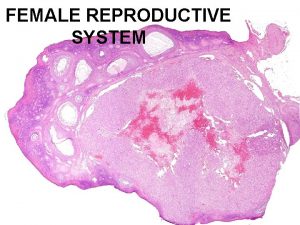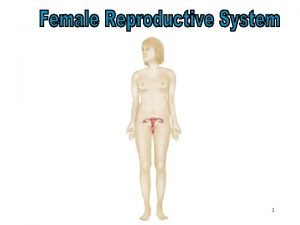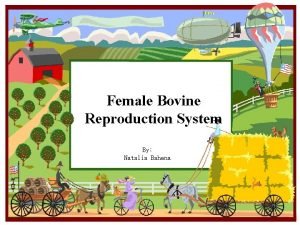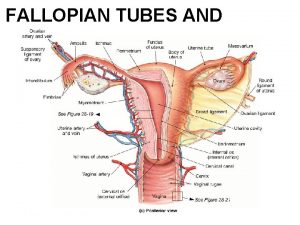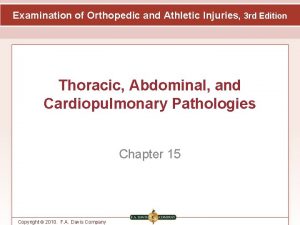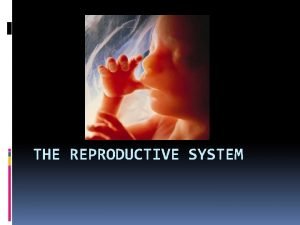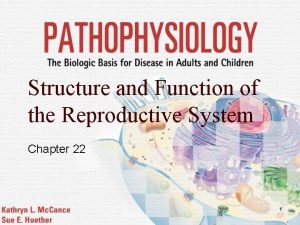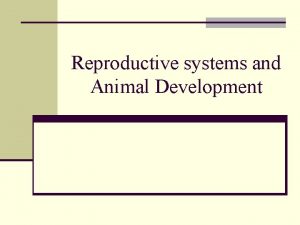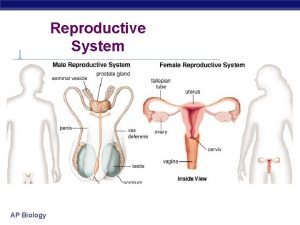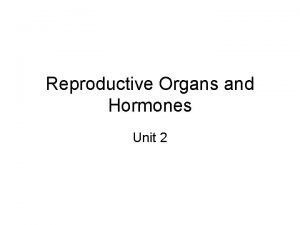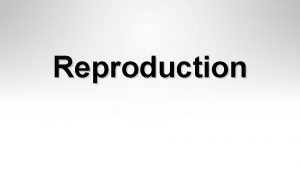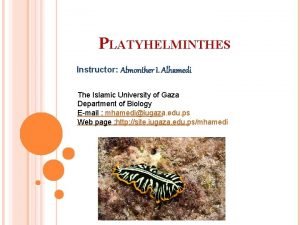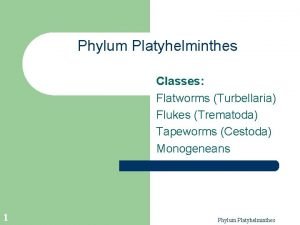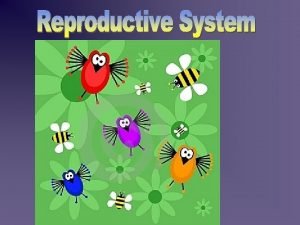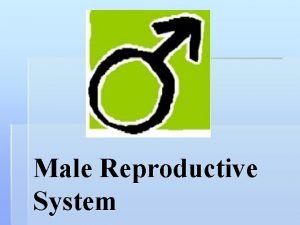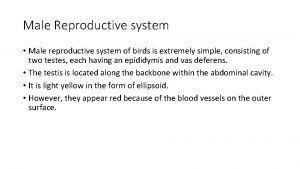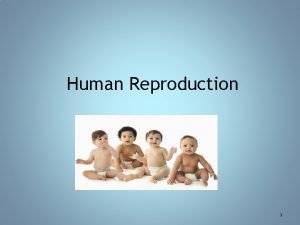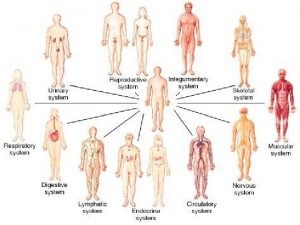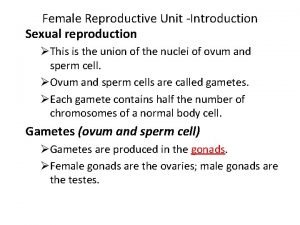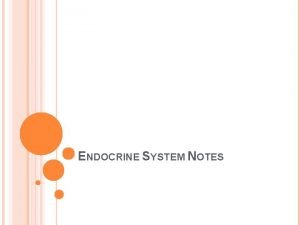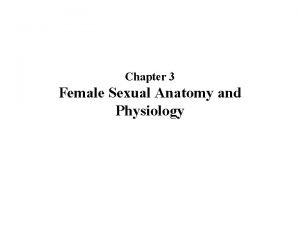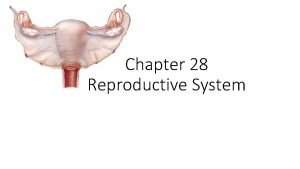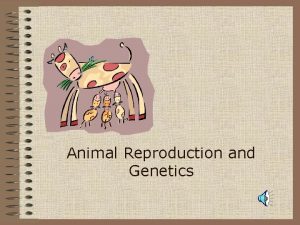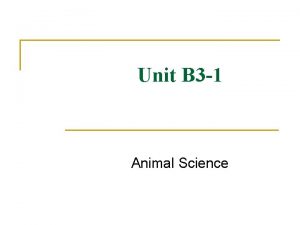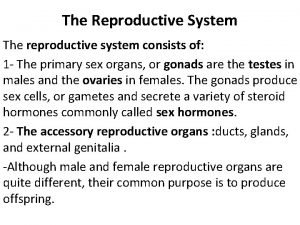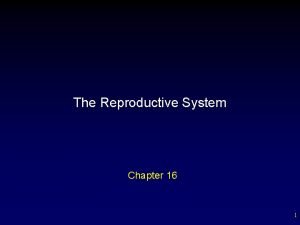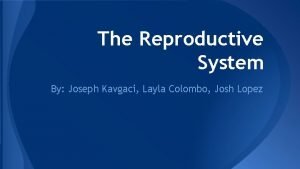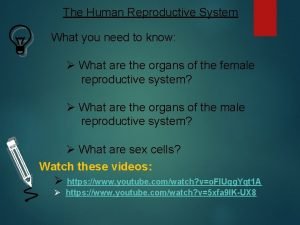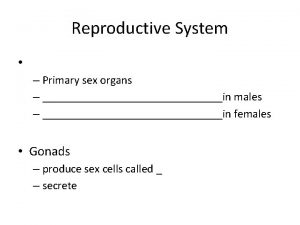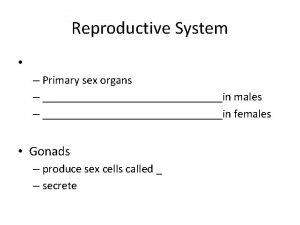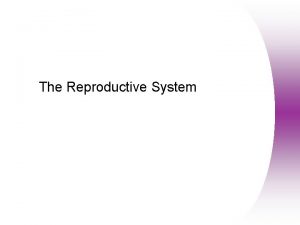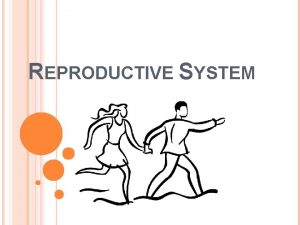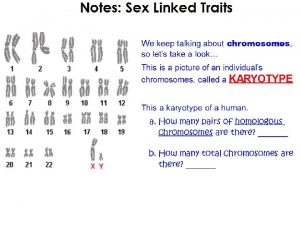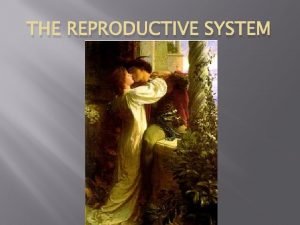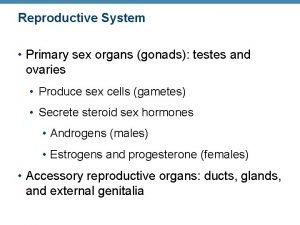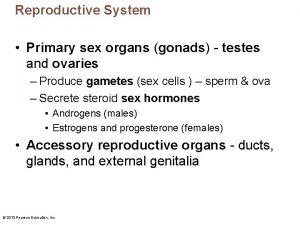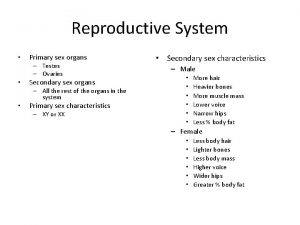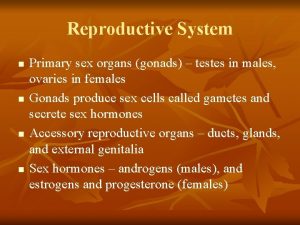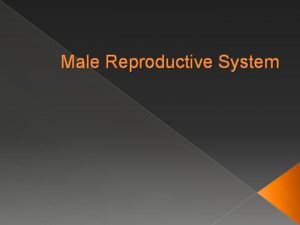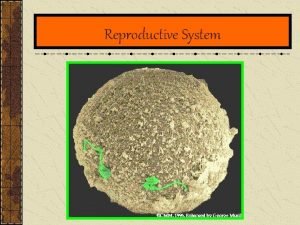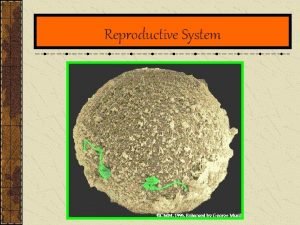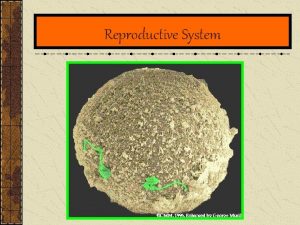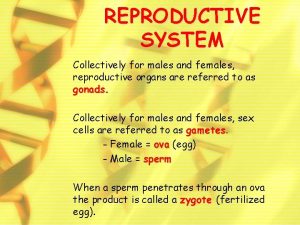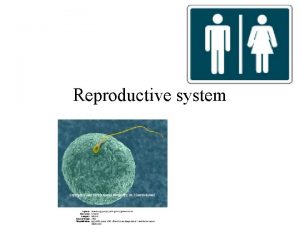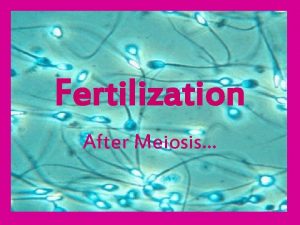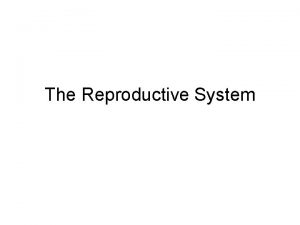Reproductive System Primary sex organs in males in








































































































































































- Slides: 168

Reproductive System • – Primary sex organs – ________________in males – ________________in females • Gonads – produce sex cells called _ – secrete

Reproductive System • Accessory reproductive organs – ducts, glands, and external genitalia • Sex hormones – – estrogens and progesterone:

Male Reproductive System • male gonads ________________ and lie within the scrotum • Sperm are delivered through a system of ducts: – – • Accessory sex glands: – Empty secretions into ducts during ejaculation – Include the seminal vesicles, prostate gland, and bulbourethral glands

Figure 27. 1

The Scrotum • Sac of skin and _ – hangs outside the body at the _ • Contains paired testicles separated by a midline septum • keeps the testes ____________ than core body temperature

The Scrotum • Intrascrotal temperature is kept constant by two sets of muscles: • – ____________________ that wrinkles scrotal skin • – bands of __________________ that elevate the testes

Figure 27. 2

The Testes • Each testis is surrounded by two tunics: – • derived from peritoneum – • fibrous capsule of the testis • Septa divide the testis into 250 -300 lobules, each containing 1 -4 seminiferous tubules

The Testes • – Produce the sperm – Converge to form the _ • The straight tubulus rectus conveys sperm to the _

The Testes • From the rete testis, the sperm: – Leave the testis _ – Enter the _ • Surrounding the seminiferous tubules are interstitial cells –

The Testes • Spermatic cord – encloses nerve fibers from ___________________ – blood vessels, – _________ that supply the testes

The Penis • A ________________ organ designed to deliver sperm into the female reproductive tract • Consists of – an attached root – a free shaft that ends in the _ – • or _ • skin covering the distal end of the penis – Circumcision • surgical removal of the foreskin after birth

The Penis • – the urethra and three cylindrical bodies of erectile tissue • – spongy network of connective tissue and smooth muscle riddled with vascular spaces • – during sexual excitement, the erectile tissue fills with blood causing the penis to enlarge and become rigid

The Penis • Corpus spongiosum – – expands to form the glans and bulb of the penis • Corpora _ – ____________ dorsal erectile bodies bound by fibrous tunica albuginea • Crura – ____________ end of the penis surrounded by the ischiocavernosus muscle; _

Epididymis • Its head joins the efferent ductules and caps the superior aspect of the testis • The duct of the epididymis has _________________ that: – Absorb testicular fluid – Pass nutrients to the sperm • __________________ enter, pass through its tubes and become motile • Upon ejaculation the _________________ , expelling sperm into the _

Ductus Deferens and Ejaculatory Duct • Runs from the epididymis through the ___________________ into the pelvic cavity • expands to form the _ • then joins the __________________ to form the ejaculatory duct • Propels sperm from the epididymis to the _

Urethra • Consists of three regions – • portion surrounded by the prostate – • lies in the urogenital diaphragm – • runs through the penis and opens to the outside at the external urethral orifice

Seminal Vesicles • Located at ______________ wall of the bladder – secrete 60% of the volume of semen • Semen – viscous _______________ fluid containing fructose, ascorbic acid, coagulating enzyme (vesiculase), and _

Seminal vesicles • Join the ductus deferens to form _ • Sperm and seminal fluid mix in the ejaculatory duct and enter the ___________________d uring ejaculation

Prostate Gland • Doughnut-shaped gland • surrounds part of the urethra _ • Plays a role in the _ • Secretions enter the prostatic urethra during ejaculation

Prostate Gland • It is milky, _______________ fluid, – contains citrate, – – – accounts for one-third of the semen volume

Bulbourethral Glands • Pea-sized glands _ • Produce ____________________ prior to ejaculation • neutralizes traces of __________________ in the urethra

Semen • Milky mixture of sperm and accessory gland secretions • Provides a _______________ and ________________ (fructose) • protects and _ • facilitates movement of sperm

Semen • Prostaglandins in semen: – Decrease the viscosity of _ – Stimulate _ – Facilitate the movement of sperm through the female reproductive tract

Semen • The hormone _________________ enhances sperm motility • Semen is a_ – Neutralizes _ – Female _ • Seminalplasmin – antibiotic chemical that _ • _______________________ coagulate semen _ – then fibrinolysin liquefies the mass

Male Sexual Response: Erection • Enlargement and stiffening of the penis from engorgement of _________________ with blood • During arousal, a __________________ promotes the release _ • Nitric oxide causes erectile tissue to fill with blood

Male Sexual Response: Erection • Expansion of the _ – ____________________ their drainage veins – _____________________ and maintains engorgement • The corpus spongiosum functions in ___________________ during ejaculation

Male Sexual Response • Erection is initiated by sexual stimuli including: – – Erotic sights, sounds, and smells • Erection can be ___________________ solely by emotional or _

Ejaculation • • The propulsion of semen from the male duct system At ejaculation, __________________ nerves cause: 1. Reproductive ducts and accessory organs to contract and _

Ejaculation • At ejaculation, sympathetic nerves cause: (continued) 2. _______________________________________, preventing the expulsion of urine 3. Bulbospongiosus muscles to undergo a rapid series of contractions 4.

Spermatogenesis • The sequence of events that produces sperm in the seminiferous tubules of the testes • Each cell has __________________ (one maternal, one paternal) and is said to be __________________ (2 n chromosomal number)

Spermatogenesis • Humans have 23 pairs of homologous chromosomes • ____________________ and are said to be _____________ (n chromosomal number) • Gamete formation is by ________________, in which the number of chromosomes is halved (from 2 n to n)

Figure 27. 8 b, c

Meiosis – Interphase • Two ________ divisions halve the number of chromosomes • Chromosomes _ Figure 27. 7. 1

Meiosis – Prophase I • Homologous chromosomes undergo _ • Tetrads are formed with _ • __________________ takes place during prophase I Figure 27. 7. 2. 1

Meiosis – Metaphase I • _________________ at the spindle equator during_ Figure 27. 7. 2. 2

Meiosis – Anaphase I • Homologous chromosomes composed of _________________ are distributed to opposite ends of the cell Figure 27. 7. 2. 3

Meiosis – Telophase I • Nuclear membrane forms around chromosomal masses • • • With telophase and cytokinesis completed, two haploid daughter cells are formed (with 2 n amount of DNA) Figure 27. 7. 2. 4

Meiosis II • Mirrors mitosis except that chromosomes are not replicated before it begins • Meiosis accomplishes two tasks: – It ______________________ by half (2 n to n) – It introduces _

Brain-Testicular Axis • Hormonal regulation of sperm production and testicular hormones involving the – – –

Brain-Testicular Axis • Testicular regulation: three sets of hormones: • Gn. RH: – ___________________ stimulates the testes through: • Follicle stimulating hormone (FSH) • Luteinizing hormone (LH) • ____________________, which _________________ stimulate the testes • Testicular hormones – exert negative feedback controls

Hormonal Regulation • The hypothalamus releases gonadotropin-releasing hormone (Gn. RH) • Gn. RH stimulates the _____________________ to secrete FSH and LH – • causes _______________________ cells to release androgen-binding protein (ABP) – • stimulates ________________________ to release testosterone • ABP binding of testosterone enhances _

Hormonal Regulation • Feedback inhibition on the hypothalamus and pituitary results from: – Rising levels of _ – Increased _ Figure 27. 10

Testosterone Activity • Testosterone – Steroid hormone: synthesized from _ • It must be transformed to exert its effects on some target cells – Prostate • it is converted into dihydrotestosterone (____) before it can bind within the nucleus – Neurons • it is ______________________ to bring about stimulatory effects

Testosterone • Testosterone targets _ • its _________________ causes these organs to _

Male Secondary Sex Characteristics • Male hormones make their appearance at puberty and induce changes in _ – Appearance of _ – Enhanced growth of the chest and deepening of the voice – Skin thickens and becomes oily – ___________________ and increase in density – Skeletal muscles increase _

Male Secondary Sex Characteristics • Testosterone is the basis of _________________ in both males and females

Female Reproductive Anatomy • ________________: primary female reproductive organs – Make female gametes • – Secrete female sex hormones • • Accessory ducts include _

Female Reproductive Anatomy • Internal genitalia – • – external sex organs

Female Reproductive Anatomy Figure 27. 11

The Ovaries • _____________ organs on each side of the uterus held in place by several ligaments – – Suspensory – Mesovarium • – contains the suspensory ligament and the mesovarium

The Ovaries Figure 27. 14 a

Ovaries • Blood supply – ___________________ and the ovarian branch of _ • They are surrounded by a fibrous tunica albuginea, – covered by a layer of epithelial cells called the _ • Embedded in the _____________ are ovarian follicles

Ovaries • Each follicle consists of an _ • Cells around the oocyte are called: – • one cell layer thick – • when ___________________ is present

Ovaries • – one layer of squamous-like follicle cells surrounds the oocyte • – two or more layers of ______________________ cells enclose the oocyte • – has a _____________________ between granulosa cells that coalesces to form a central _

Ovaries • – secondary follicle at its ___________________ that bulges from the surface of the ovary • Ovulation – _____________________ from the ripening follicle • – ruptured follicle _

Ovaries

Fallopian Tubes • Receive the _ • provide a _ • Empty into the uterus via the isthmus • Expand distally around the ovary forming the _ • The ampulla ends in the funnel-shaped, ciliated infundibulum containing fingerlike projections called fimbriae

Uterine Tubes • The uterine tubes have _________________ with the ovaries and the ovulated oocyte is cast into the _ • Beating _____________ on the fimbriae create currents to carry the oocyte into the uterine tube

Uterine Tubes • The oocyte is carried toward the uterus by _ • Nonciliated cells keep the oocyte and the _

Uterus • Hollow, thick-walled organ • located in the pelvis ______________________ and posterosuperior to the bladder • – major portion of the uterus • – rounded region superior to the entrance of the uterine tubes • – narrowed region between the body and cervix

Uterus • – narrow ________________ which projects into the vagina inferiorly • Cervical canal – cavity of the cervix that communicates with: • The vagina via the _ • The uterine body via the _ • Cervical glands ____________________ that covers the external os and _______________________ except during midcycle

Uterine Wall • three layers – • outermost serous layer • the visceral peritoneum – • middle layer • smooth muscle – • mucosal lining of the uterine cavity

Endometrium • Has numerous uterine glands that change in length as the endometrial thickness changes • – Undergoes cyclic changes in response to ovarian hormones – Is shed during _ • – Forms a new functionalis after menstruation ends – Does not respond to ovarian hormones

Uterine Vascular Supply • Uterine arteries – arise from _ – ascend the sides of the uterus and send branches into the uterine wall • – branches of the uterine arteries in the myometrium that give rise to radial branches

Uterine Vascular Supply • Radial branches – descend into the endometrium and give off: – ___________________ to the stratum functionalis – ___________________ to the stratum basalis

Uterine Vascular Supply • ___________________ causes the functionalis to shed during menstruation

Vagina • Thin-walled tube • between the _ • The urethra is embedded in the anterior wall • Provides a passageway for birth, menstrual flow, and is the organ of copulation

Vagina • Wall consists of three coats: – fibroelastic adventitia – smooth muscle muscularis, – stratified squamous mucosa • _______________ near the ____________________ forms an incomplete partition called the _ • Vaginal _ – upper end of the vagina surrounding the cervix

Vagina

Female External Genitalia: Deep Figure 27. 16 b

External Genitalia: Vulva • ________________: Lies external to the vagina and includes – – Labia – – Vestibular structures

External Genitalia: Vulva • Mons pubis – round, _________________ overlying the _ • Labia _ – elongated, hair-covered, _ – homologous to the _

External Genitalia: Vulva • Labia _ – _________________ skin folds lying within the labia majora – homologous to the _ • Greater _ – Pea-size glands flanking the vagina – Homologous to _ – Keep the vestibule _

External Genitalia: Vulva (Pudendum) • Clitoris (_______________) – – exposed portion is the _ • – Diamond-shaped region between the pubic arch and coccyx – Bordered by the ____________________ laterally

Mammary Glands • Modified _______________ consisting of 15 -25 lobes that radiate around and open at the nipple • – pigmented skin surrounding the nipple • __________________ attach the breast to underlying muscle fascia

Mammary Glands • Lobes contain __________________ that _________________ in lactating women • Compound alveolar glands pass milk to ___________________, which open to the outside

Structure of Lactating Mammary Glands Figure 27. 17

Breast Cancer • Usually arises from the epithelial cells of the ducts • Risk factors include: – _______________________ or late menopause – No pregnancies or the _ – Previous history of breast cancer or family history of breast cancer – Hereditary factors including mutations to the genes BRCA 1 and BRCA 2 • __________ of women with breast cancer have _

Detection and Treatment • Early detection is by _____________________ and mammography • Treatment depends upon the characteristics of the lesion • Radiation, chemotherapy, and surgery followed by irradiation and chemotherapy • Today, ____________________ is the surgery used rather than radical mastectomy

Oogenesis • Production of _ • In the fetal period, oogonia (2 n ovarian stem cells) multiply by mitosis and store nutrients • __________________ appear as oogonia are transformed into _

Oogenesis: Puberty • Primary oocytes begin meiosis but _ • At puberty, one activated primary oocyte produces two haploid cells – The first _ – The secondary _ • The secondary oocyte arrests in ___________________ and is ovulated

Oogenesis: Puberty • ___________________ the second oocyte completes meiosis II, yielding: – One large ovum (the functional gamete) – A tiny second _


Ovarian Cycle • Monthly series of events associated with the maturation of an egg • – period of ____________________ (days 1– 14) • – period of corpus luteum activity (days 14– 28) • Ovulation occurs _

Follicular Phase • The primordial follicle, directed by the oocyte, becomes a _ • Primary follicle becomes a _ – The theca folliculi and granulosa cells cooperate to produce estrogens – The __________________ forms around the oocyte – The antrum is formed

Follicular Phase • The secondary follicle becomes a vesicular follicle – The __________________ and isolates the oocyte and the corona radiata – The full size follicle (vesicular follicle) _________________ from the external surface of the ovary – The primary oocyte completes meiosis I, and the stage is set for ovulation

Ovarian Cycle Figure 27. 20

Ovulation • Ovulation occurs when the _ • Mittelschmerz – a twinge of ______________ sometimes felt at _ • 1 -2% of ovulations release more than one secondary oocyte, which if fertilized, results in fraternal twins

Luteal Phase • After ovulation, – the ruptured _ – forms the _ • The corpus luteum secretes _

Luteal Phase • If pregnancy does not occur: – the corpus luteum degenerates in 10 days, leaving a scar • • If pregnancy does occur – the corpus luteum produces hormones _ • at about 3 months

Establishing the Ovarian Cycle • During childhood, – ovaries grow – secrete small amounts of _ – inhibit the hypothalamic release of Gn. RH • As puberty nears, – Gn. RH is released – • These events continue until an adult cyclic pattern is achieved and menarche occurs

Hormonal Interactions During the Ovarian Cycle • Day 1 – Gn. RH from _______________ stimulates the release of ___________________ from anterior pituitary • Over the next several days, FSH and LH _ • As the follicle matures, it begins to produce and release estrogen • Rising estrogen levels: –

Hormonal Interactions During the Ovarian Cycle • Estrogen levels increase • high estrogen levels have a ___________________, causing a sudden surge of _

Hormonal Interactions During the Ovarian Cycle • The LH spike stimulates the primary oocyte to complete meiosis I, and the secondary oocyte continues on to metaphase II • Day 14 –

Hormonal Interactions & the Ovarian Cycle • LH transforms the ruptured follicle into a _ – produces inhibin, progesterone, and estrogen • These hormones shut off ___________________ release and declining LH ends luteal activity • Days 26 -28 – decline of the ovarian hormones – Ends the blockade of FSH and LH – The cycle starts anew

Feedback Mechanisms in Ovarian Function

Uterine (Menstrual) Cycle • Series of cyclic changes that the uterine endometrium goes through each month in response to ovarian hormones in the blood • – _________________________– uterus sheds all but the deepest part of the endometrium • Days 6 -14: – _________________________ (preovulatory) phase – endometrium rebuilds itself • Days 15 -28: – _________________________ (postovulatory) phase – endometrium prepares for implantation of the embryo

Menses • If fertilization does _________ occur – – deprives the endometrium of hormonal support • _____________________ spasms and endometrial cells begin to die as blood flow is interupted • The functional layer begins to _ • Spiral arteries constrict one final time then suddenly relax and open wide • The rush of blood fragments weakened capillary beds and _


Extrauterine Effects of Estrogens and Progesterone • Estrogen levels _ • Promote oogenesis and follicle growth in the ovary • Exert _________________ on the female reproductive tract – Uterine tubes, uterus, and vagina grow larger and become functional – Uterine tubes and uterus exhibit _ – Vaginal mucosa thickens and _

Estrogen-Induced Secondary Sex Characteristics • Growth of the _ • Increased deposition of ___________________, especially in the hips and breasts • Widening and lightening of the pelvis • Growth of _

Female Sexual response • _________________ nerve impulses cause arteries of erectile tissues to dilate – Blood flow _ – erectile tissues swell – Vagina begins to _

Female Sexual Response • parasympathetic impulses stimulate – ____________________ to secrete ________________ into the vestibule. • serves to moisten and lubricate the tissues, • • prevent irritation of tissues and _

Female orgasm • The culmination of stimulation is _ • the ______________________________________________ resulting in an increased friction. • Orgasm initiates a series of reflexes in which the – muscles of the perineum – walls of the uterus and fallopian tubes _ • The contractions help to _______________________ towards the uterine tubes.

Female Sexual Response • Females do not have a __________________ after orgasm and can experience multiple orgasms in a single sexual experience • Orgasm is _______________ for conception

Sexually Transmitted Diseases: Gonorrhea • Bacterial infection caused by Neisseria gonorrhoeae, • spread by contact with _ • Signs and symptoms – In males • ______________________, discharge of pus from the penis – In females • • abdominal discomfort, vaginal discharge, abnormal uterine bleeding – Often mild symptoms are _____________________ or vaginosis

STD: Gonorrhea – Left untreated, can result in • pelvic inflammatory disease in women – May damage fallopian tubes and result in ectopic pregnancies or infertility • • According to the CDC: – In the United States, the highest reported rates of infection are among _

STD: Gonorrhea • Prevention – Abstinence – – _____________________ reduces transmission • Treatment: – antibiotics, but resistant strains are becoming more prevalent

STD: Syphilis • Bacterial infection from Treponema pallidum • transmitted sexually or _ • “_______________” because signs and symptoms coincide with other disorders • Primary stage: –A ________________ appears at the site of infection and disappears in a few weeks

s. TD: Syphilis • time between infection and the start of the first symptom – from __________________ (average 21 days). – The chancre is usually ______________________, and painless. – It appears at the spot where syphilis entered the body. – The chancre ____________________, and it ________________________. However, if adequate treatment is not administered, the infection progresses to the secondary stage.

STD: Syphilis • _____________________ shows signs of pink skin rash, fever, and joint pain – Other symptoms include swollen lymph glands, sore throat, patchy hair loss, headaches, weight loss, muscle aches, and fatigue. – • A _______________ period follows, which may progress to tertiary syphilis characterized by gummas (lesions of the CNS, blood vessels, bones, and skin) – difficulty coordinating muscle movements, paralysis, numbness, gradual blindness, and dementia. • Treatment:

STD: Chlamydia • Most common STD in the U. S. • Bacteria: Chlamydia trachomatis • Symptoms include – – penile and vaginal discharges; – abdominal, rectal, or testicular pain; – – irregular menses • Can cause _______________________ and urinary tract infections in men, and sterility in women • “______________________" disease because about three quarters of infected women and about half of infected men have no symptoms • Prevention: abstinence, latex condoms reduce risk • Treatment is with tetracycline

STD: Viral Infections • human papillomaviruses (HPV) – Low risk varieties can cause ____________________ and abnormal Pap smears – High risk varieties can increase the risk of _ • Transmitted through _ • Condoms do not prevent transmission of HPV, but have been show to reduce rates of cervical cancer

Sexually Transmitted Diseases: Viral Infections • Genital herpes – caused by Herpes Simplex Virus (HSV) – Herpetic lesions appear as _ – characterized _ • Can be passed to partner when sores are present OR absent – Congenital herpes can cause malformations of a fetus – Has been implicated with _ – Treatment: acyclovir and other antiviral drugs

Pap Smears • Named for Dr. Papanicolaou • ___________________________t aken from external os and surrounding tissues for evaluation • Samples taken from the Squamo-columnar Junction. • circular area right at the opening of the cervix where the pink, smooth skin of the cervix meets the fiery-red, fragile, mucousproducing lining of the cervical canal. • If there is a problem with cancer or precancerous changes, it is this area that is most likely to be effected. This area of ________________________ is also known as the _

Pelvic Inflammatory Disease • General term for infection of _ – Often stemming from sexually transmitted diseases • • – Can damage uterus, fallopian tubes, and ovaries resulting in ____________________, abscesses, and chronic pain

Pelvic Inflammatory Disease • Risk factors – – – • alters vaginal environment and allows bacteria to thrive • Forces bacteria through cervical canal • Symptoms: most commonly include _. – fever, unusual vaginal discharge that may have a foul odor, – painful intercourse, painful urination, irregular menstrual bleeding, and pain in the right upper abdomen (rare).

Endometriosis • Endometrial tissue normally found within the uterus is located within the pelvic cavity, commonly on ovaries – Fallopian tubes, uterine ligaments, intestines, bladder, vagina, cervix • Sympoms: • • pain during or after sexual activity • Infertility • • Other symptoms may include fatigue; painful bowel movements with periods; ____________________; diarrhea and/or constipation and other intestinal upset with some periods. • Some women with endometriosis have no symptoms. Infertility affects about 30 -40% of women with endometriosis and is a common result with progression of the disease.

PMS: pre Menstrual syndrome • symptoms usually _ • Symptoms usually stop when menstruation begins, or shortly thereafter. • exact cause of PMS has not been identified • estimated to affect up _______________ during their childbearing years • Symptoms: – headache, ankle swelling, back ache, abdominal cramps, abdominal pain, breast tenderness, weight gain, cold sores, acne flare-ups, nausea, constipation/diarrhea, food cravings, irritable, clumsy

Dysmenorrhea • • Begins a day or so before menstruation and ends when the bleeding stops • May be related to _ • Primary dysmenorrhea: – occurs in “healthy” women. – not related to any specific problems with the uterus or other pelvic organs. • Secondary dysmenorrhea: – caused by ____________________ or structural abnormality either within or outside the uterus

Genetic Sex Determination • Genetic sex is determined by the sex chromosomes each gamete contains • There are two types of sex chromosomes_ • Females have two X chromosomes; males have one X and one Y • Hence, all eggs have an X chromosome; half the sperm have an X, and the other half a Y • A single gene on the Y chromosome, the _____________, initiates testes development and determines maleness

Development of External Genitalia: Male • Under the influence of testosterone • _________________ enlarges forming the penis • __________________ elongates and closes completely • Urethral folds give rise to the _ • __________________ swellings develop into the scrotum

Development of External Genitalia: Female • In the _ • Genital tubercle gives rise to the _ • The ________________ as the vestibule • The urethral folds become _ • The labioscrotal swellings _

Descent of the Gonads • About 2 months before birth and stimulated by testosterone, the _____________________ and enter the scrotum • – fibrous cord that extends from the testes to the scrotum • Spermatic cord – blood vessels, nerves, and fascial layers that help suspend the testes • Ovaries also descend, but are ________________________ at the pelvic brim

Development Aspects: Puberty • Reproductive organs grow to adult size and become functional • Secondary sex characteristics appear • Characteristics of puberty – Males • _____________________ and scrotum, appearance of axillary and facial hair, _ – Females • enlarging of the breasts, __________________ , and dependable ovulation

Menopause • Ovulation and menses _ • Without sufficient _____________ , reproductive organs and breasts atrophy – – Skin blood vessels undergo intense vasodilation (hot flashes occur) – Gradual thinning of the skin and bone loss • Males have no equivalent to menopause

From Egg to Embryo • Pregnancy – events that occur from _ • – the developing offspring • – from the last menstrual period until birth

From Egg to Embryo • Preembryo – conceptus from _ • Embryo – conceptus during the _ • Fetus – conceptus from the _

Accomplishing Fertilization • The oocyte is viable for _ • Sperm is viable _ • For fertilization to occur, coitus must occur no more than: – Three days before ovulation – 24 hours after ovulation • Fertilization – when a sperm fuses with an egg to _

Sperm Transport and Capacitation • Fates of ejaculated sperm: – Leak out of the vagina immediately after deposition – – Fail to make it through the cervix – Dispersed in the uterine cavity or destroyed by _ – Reach the uterine tubes • Sperm must undergo ________________ before they can penetrate the oocyte

Acrosomal Reaction and Sperm Penetration • An ovulated oocyte is encapsulated by: – The _ – Extracellular matrix • Sperm binds to the zona pellucida and undergoes the _ – ___________________ are released near the oocyte – Hundreds of acrosomes release their enzymes _


Completion of Meiosis II and Fertilization • Upon entry of sperm, the secondary oocyte: – – Casts out the second polar body • The ovum nucleus swells, and the two nuclei approach each other • When fully swollen, the two nuclei are called _ • Fertilization – when the _

Preembryonic Development • The first cleavage produces _ • – the 16 or more cell stage (72 hours old) • By the fourth or fifth day the preembryo consists of 100 or so cells (blastocyst)

Preembryonic Development • • a fluid-filled hollow sphere composed of: – A single layer of _ – An _ • Trophoblasts take part in _ • The inner cell mass becomes the _

Cleavage: From Zygote to Blastocyst

Implantation • Begins ___________________ when the trophoblasts adhere to a properly prepared endometrium • The trophoblasts then proliferate and form _ – Cytotrophoblast • cells of the inner layer that retain their cell boundaries – Syncytiotrophoblast • cells in the outer layer that lose their plasma membranes _

Implantation • The implanted blastocyst is covered over by endometrial cells • Implantation is completed by the _

Implantation • Viability of the corpus luteum is maintained by human chorionic gonadotropin (________) secreted by the _ • h. CG prompts the corpus luteum to continue to secrete progesterone and estrogen • Chorion – developed from trophoblasts after implantation, continues this hormonal stimulus • Between the second and third month, the placenta: – Assumes the role of progesterone and estrogen production – Is providing _

Placentation • Formation of the placenta from: – – ___________________ endometrial tissues • The placenta is fully formed and functional by the _

Placentation • Embryonic placental barriers include: – The _ – The endothelium of embryonic capillaries • The _______________ also secretes other hormones – human placental lactogen, human chorionic thyrotropin, and relaxin

Embryonic Membranes • Amnion – Provides a ___________________ that protects the embryo – Helps maintain _ – Amniotic fluid comes from maternal blood, and later, fetal urine

Embryonic Membranes • – Forms part of the _ – Produces earliest _____________ and vessels – Is the source of primordial germ cells

Embryonic Membranes • – a small outpocketing at the caudal end of the yolk sac – Structural base for the _ – Becomes part of the _ • – helps form the _ – Encloses the embryonic body and all other membranes

Gastrulation • During the 3 rd week, the ___________________b ecomes a _ • The primary germ layers are ectoderm, mesoderm, and endoderm

Primary Germ Layers • Serve as primitive tissues from which all body organs will derive • – forms structures of the nervous system and skin epidermis • – forms epithelial linings of the digestive, respiratory, and urogenital systems • – forms all other tissues • Endoderm and ectoderm are securely joined and are considered epithelia

Effects of Pregnancy • – ____________________ develops a purplish hue • Breasts enlarge and their _ • The uterus expands, occupying most of the abdominal cavity

Effects of Pregnancy • _______________ is common due to the change of the body’s center of gravity • _______________ causes pelvic ligaments and the pubic symphysis to relax • Typical weight gain is about 29 pounds

Effects of Pregnancy: Metabolic Changes • The placenta secretes human placental lactogen (h. PL), – stimulates the _ – promotes growth of the fetus and exerts a maternal glucose-sparing effect • Human chorionic thyrotropin (h. CT) _ • Parathyroid hormone levels are high, ensuring a_

Effects of Pregnancy: Physiological Changes • GI tract – morning sickness occurs due _ • Urinary system – ________________________ to handle the additional fetal wastes • Respiratory system – – Dyspnea (difficult breathing) may develop late in pregnancy

Effects of Pregnancy: Physiological Changes • Cardiovascular system – 25 -40% – Venous pressure from lower limbs is impaired, resulting in _

Parturition: Initiation of Labor • Estrogen reaches a peak during the last weeks of pregnancy causing _ • Weak Braxton Hicks contractions may take place • As birth nears, ____________________ cause uterine contractions • Emotional and physical stress: – Activates the hypothalamus – Sets up a ____________________ mechanism, releasing more oxytocin

Parturition: Initiation of Labor

Stages of Labor: Dilation Stage • From the onset of labor ____________________(10 cm) • Initial contractions are 15– 30 minutes apart and 10– 30 seconds in duration • The cervix _ • The _____________________, releasing amniotic fluid (breaking of the water) • ______________________ occurs as the infant’s head enters the true pelvis

Stages of Labor: Dilation Stage

Stages of Labor: Expulsion Stage • From full dilation to _ • Strong contractions occur every _ • The _________________ increases in labor without local anesthesia • ___________________ occurs when the largest dimension of the head is distending the vulva

Stages of Labor: Expulsion Stage

Stages of Labor: Expulsion Stage • The delivery of the placenta is accomplished _ • Afterbirth – the placenta and its attached fetal membranes • All placenta fragments must be removed to prevent _

Stages of Labor: Expulsion Stage

Extrauterine Life • At 1 -5 minutes after birth, the infant’s physical status is assessed based on five signs: – • Each observation is given a score of _ • Apgar score – the total score of the above assessments – – Lower scores reveal problems

Occlusion of Fetal Blood Vessels • _______________________ constrict and become _ • Fates of fetal vessels – Proximal umbilical arteries become _______________________ and distal parts become the _ – The umbilical vein becomes the _ – The ductus venosus becomes the _ – The _____________________ becomes the fossa ovalis – The ductus arteriosus becomes the ligamentum arteriosum

Transitional Period • Unstable period lasting 6 -8 hours after birth • The _________________ the baby is alert and active – Heart rate increases (120 -160 beats/min. ) – – Temperature _

Transitional Period • Activity then _____________ and the infant sleeps about _ • A second active stage follows in which the baby _ • After this, the infant sleeps, with waking periods occurring every 3 -4 hours

Lactation • The production of milk by the _ • Estrogens, progesterone, and lactogen stimulate the hypothalamus to release _ • The _________________ responds by releasing _

Lactation • – Solution rich in vitamin A, protein, minerals, and Ig. A antibodies – Is released the _ – Is followed by _______________ production

Lactation and Milk Let-down Reflex • After birth, milk production is _ Figure 28. 18

Breast Milk • Advantages of breast milk for the infant – Fats and iron are _ – Its amino acids are metabolized ________________________ than those of cow’s milk – Beneficial chemicals are present – _________, other immunoglobulins, complement, lysozyme, ______________________, and lactoperoxidase – Interleukins and prostaglandins are present, which prevent overzealous inflammatory responses – Its _______________________ help cleanse the bowels of meconium
 Primary sex organ of the male reproductive system? *
Primary sex organ of the male reproductive system? * Sex sex sex
Sex sex sex Greenhouse sex
Greenhouse sex Xxtesticles
Xxtesticles Sex sex sex
Sex sex sex Sex sex sex
Sex sex sex What is gonad
What is gonad In males, fsh prods these organs to produce testosterone.
In males, fsh prods these organs to produce testosterone. Female hymen
Female hymen Infindibulum
Infindibulum Reproductive organs of the bull
Reproductive organs of the bull Perinetrium
Perinetrium Cow male reproductive system
Cow male reproductive system Function of reproductive organs
Function of reproductive organs The reproductive system chapter 16
The reproductive system chapter 16 Female anatomy
Female anatomy Sex linkage example
Sex linkage example What is sex linkage in biology
What is sex linkage in biology Sex determination and sex linkage
Sex determination and sex linkage Once a sex offender always a sex offender
Once a sex offender always a sex offender Primary and secondary retroperitoneal organs
Primary and secondary retroperitoneal organs Primary and secondary retroperitoneal organs
Primary and secondary retroperitoneal organs Female anatomy labeled
Female anatomy labeled Endocrine system and reproductive system
Endocrine system and reproductive system Secondary sex characteristics
Secondary sex characteristics Sensory system organs
Sensory system organs Purpose of excretory system
Purpose of excretory system Major and accessory organs of the digestive system
Major and accessory organs of the digestive system Accessory organs of the digestive system
Accessory organs of the digestive system Accessory organs of the digestive system
Accessory organs of the digestive system Lymphatic system and urinary system
Lymphatic system and urinary system Formation of lymph
Formation of lymph Venule
Venule Function of lymphatic system
Function of lymphatic system Organs of the sensory system
Organs of the sensory system Which organs are involved in respiratory system
Which organs are involved in respiratory system Chapter 13 respiratory system
Chapter 13 respiratory system Chapter 16 matching questions 6-10
Chapter 16 matching questions 6-10 What is the relative frequency for males ?
What is the relative frequency for males ? Thrill oriented killer
Thrill oriented killer Thelarche meaning
Thelarche meaning Puberty in males
Puberty in males Me han dejado a mi fuente de agua viva
Me han dejado a mi fuente de agua viva Diagram wet dreams
Diagram wet dreams What is a pedigree?
What is a pedigree? Http://www.cellsalive.com/meiosis.htm
Http://www.cellsalive.com/meiosis.htm Turner syndrome in males
Turner syndrome in males Kleinfelters syndrome
Kleinfelters syndrome Jacob syndrom
Jacob syndrom Lh and fsh in males
Lh and fsh in males Males with extra y chromosome
Males with extra y chromosome Spermatogenesis
Spermatogenesis Mia malemo
Mia malemo Turner syndrome in males
Turner syndrome in males Hypergonadism in males
Hypergonadism in males Hypergonadism in males
Hypergonadism in males Hypergonadism in males
Hypergonadism in males Adrenarche age 7
Adrenarche age 7 Physical signs of lost virginity in males
Physical signs of lost virginity in males Fccla star event dress code images
Fccla star event dress code images Puberty meaning
Puberty meaning The unequal access of males and females to property
The unequal access of males and females to property Måleenhet for elektrisk spenning
Måleenhet for elektrisk spenning Male reproductive system from front
Male reproductive system from front Reproductive hygiene
Reproductive hygiene Male and female reproductive system
Male and female reproductive system Fetus reproductive system
Fetus reproductive system Ovarian ligament.
Ovarian ligament. Exercise 42 anatomy of the reproductive system
Exercise 42 anatomy of the reproductive system Female reproductive system external
Female reproductive system external Oogenesis process
Oogenesis process Female reproductive system pregnancy
Female reproductive system pregnancy Unit 6:14 reproductive system
Unit 6:14 reproductive system Copyright
Copyright Reproductive system jeopardy
Reproductive system jeopardy Female and male reproductive system
Female and male reproductive system Reproductive system definition
Reproductive system definition Reproductive physiology
Reproductive physiology Chicken uterus
Chicken uterus Male reproductive system in plant
Male reproductive system in plant Art-labeling activity: the male reproductive system, part 1
Art-labeling activity: the male reproductive system, part 1 Male chicken cloaca
Male chicken cloaca Male reproductive system information
Male reproductive system information Where semen stored
Where semen stored Male cow reproductive system diagram
Male cow reproductive system diagram Male prostate
Male prostate Lesson 3 the female reproductive system
Lesson 3 the female reproductive system Male reproductive system plants
Male reproductive system plants Disease traductor
Disease traductor Cartilaginous fish reproduction
Cartilaginous fish reproduction Primary follicle
Primary follicle Renal
Renal Female reproductive system of pila
Female reproductive system of pila Juxtaposing in earthworm
Juxtaposing in earthworm Urogenital papilla fetal pig
Urogenital papilla fetal pig Claspers are structures involved in:
Claspers are structures involved in: Female part of a flower
Female part of a flower How to care reproductive system
How to care reproductive system Figure 28-2 the female reproductive system
Figure 28-2 the female reproductive system Chapter 21 reproductive system review questions
Chapter 21 reproductive system review questions Chapter 20 reproduction and pregnancy
Chapter 20 reproduction and pregnancy Chapter 17 reproductive system diseases and disorders
Chapter 17 reproductive system diseases and disorders Chapter 16 the reproductive system figure 16-2
Chapter 16 the reproductive system figure 16-2 Chapter 16 lesson 3 the female reproductive system
Chapter 16 lesson 3 the female reproductive system Chapter 14 the reproductive system labeling exercises
Chapter 14 the reproductive system labeling exercises Female cow reproductive system
Female cow reproductive system Figure 28-1 the male reproductive system
Figure 28-1 the male reproductive system Reptilian reproductive system
Reptilian reproductive system Plants reproductive system
Plants reproductive system Colon function in male reproductive system
Colon function in male reproductive system Figure 16-1 male reproductive system
Figure 16-1 male reproductive system Differences between male and female reproductive organ
Differences between male and female reproductive organ Reproductive system objectives
Reproductive system objectives Female reproductive system label
Female reproductive system label Pg
Pg Pathway of semen
Pathway of semen Function of fallopian tube
Function of fallopian tube Isthmus of fallopian tube
Isthmus of fallopian tube Male reproductive system table
Male reproductive system table Corpus vagina
Corpus vagina Lesson 3 the female reproductive system
Lesson 3 the female reproductive system Female reproductive system color
Female reproductive system color Gyneoid
Gyneoid Chapter 8 female reproductive system
Chapter 8 female reproductive system Drawing of the male and female reproductive system
Drawing of the male and female reproductive system Toad digestive system
Toad digestive system Conclusion of female reproductive system
Conclusion of female reproductive system Mesosalpinx
Mesosalpinx Boar reproductive system
Boar reproductive system Female reproductive system pathology
Female reproductive system pathology The reproductive system chapter 16
The reproductive system chapter 16 Distinguish between ova ovaries and ovulation
Distinguish between ova ovaries and ovulation Bovine female reproductive system
Bovine female reproductive system Summary of the reproductive system
Summary of the reproductive system Female reproductive system pathology
Female reproductive system pathology Female reproductive system pathology
Female reproductive system pathology Layers of scrotum anatomy
Layers of scrotum anatomy Penile urethra
Penile urethra Female reproductive system
Female reproductive system Abortion types
Abortion types Uterine seal
Uterine seal Bovine female reproductive system
Bovine female reproductive system Female reproductive system anatomy
Female reproductive system anatomy Female reproductive system pathology
Female reproductive system pathology What is the joining of egg and sperm called
What is the joining of egg and sperm called Where are the seminiferous tubules located
Where are the seminiferous tubules located Reproductive system
Reproductive system Reproductive system
Reproductive system Female reproductive system labeled
Female reproductive system labeled Female reproductive
Female reproductive Fertilization
Fertilization Epidermis
Epidermis Turbellaria and trematoda
Turbellaria and trematoda Prostatic urethra
Prostatic urethra Does urine and sperm come from the same tube
Does urine and sperm come from the same tube What is reproductive system
What is reproductive system Female reproductive system external
Female reproductive system external Human body organ systems
Human body organ systems Anterior view of the female reproductive system
Anterior view of the female reproductive system A hormone
A hormone External genitalia of female
External genitalia of female Erected
Erected Male reproductive system of mammals
Male reproductive system of mammals Animal female reproductive system diagram
Animal female reproductive system diagram Chapter 16 lesson 3 the female reproductive system
Chapter 16 lesson 3 the female reproductive system Female reproductive system definition
Female reproductive system definition Anatomy of the human ovary
Anatomy of the human ovary Sperm fructose
Sperm fructose Cells in the reproductive system
Cells in the reproductive system
